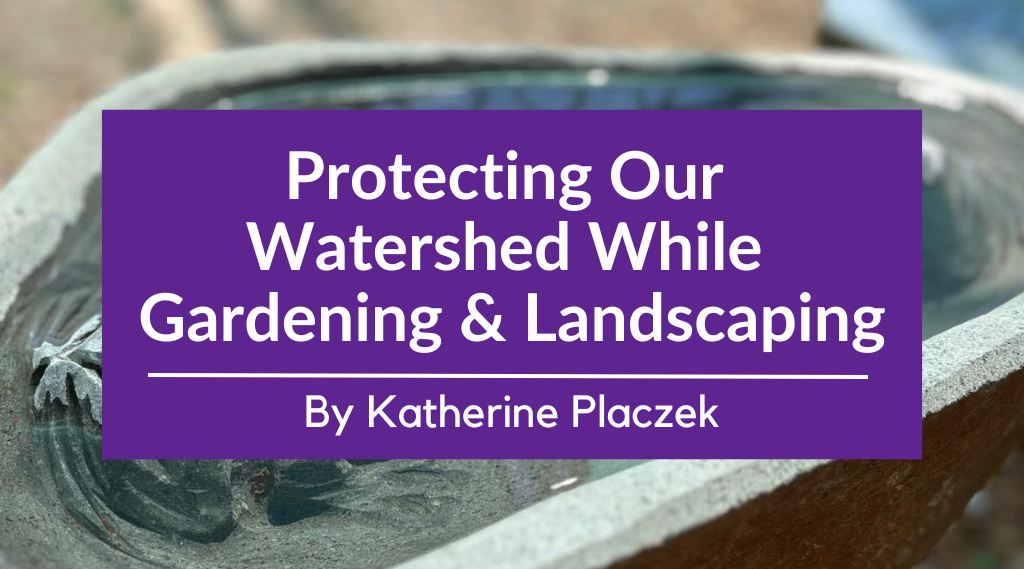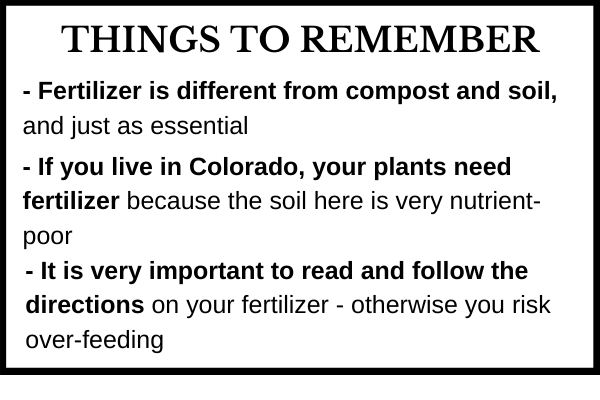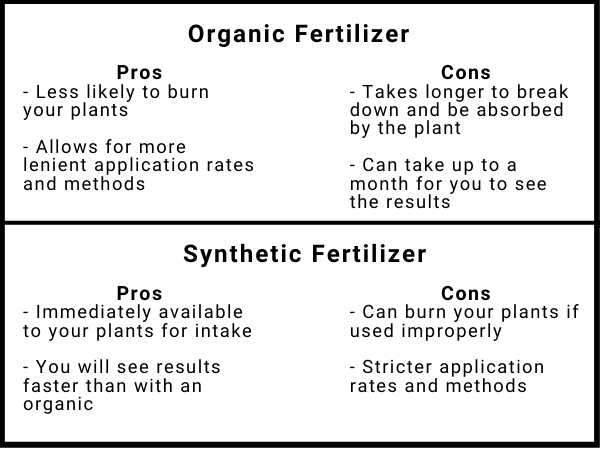Protecting Our Watershed While Gardening & Landscaping
By Katherine Placzek
Every item that we use in our green spaces– fertilizers, pesticides, sprays, powders and granules, etc. all make their way into the water, after it rains or when we water our plants. This means a myriad of compounds, organic and synthetic, are making their way in our or someone’s drinking water. Yes, most of our drinking water is filtered, but this also impacts lakes, streams, aquifers, wells, and other sources of water that can be a habitat for other living organisms, big and small. While this may feel overwhelming initially, we have the power to make little meaningful changes in the way we manage our landscapes.
Lawn and Garden Fertilization
Three things make a difference here. Quantity, quality and timing:
Quantity: When you use fertilizer, always use the instructed amount of fertilizer or a diluted/ lesser amount. This ensures that your plants can take up the applied fertilizer and that excess is not making its way into our waterways. Excess fertilization can stress plants and negatively impact water quality. Over fertilizer use through agriculture, golf course maintenance, and community landscaping have contributed to dead zones in waterways. A dead zone is where all aquatic life ceases to exist. First, expansive algae blooms occur that crowd out sunlight, which choke oxygen out of the environment, causing inhabitable levels for any life, plant or animal. While some dead zones do occur naturally, the second largest one in the world is in the Gulf of Mexico, where many of North America’s waterways meet. This dead zone is widely attributed to human causes.
Quality: When choosing a fertilizer, it is advisable to read the ingredients, similar to reading food labels. If you cannot recognize an ingredient, know it is likely synthetic. Not all things that are human made are bad, but do your research. You may decide that you do not want some of these ingredients in your garage, home, yard, and local ecosystem. This is why Rick’s is proud to continue to carry our Organic Lawn and Garden fertilizers. Both of these are gentle fertilizers, with low nitrogen levels, and contain ingredients such as chicken manure, bone meal and blood meal.
Timing: Never fertilize before a severe rainstorm where run-off can take the majority of your fertilizer downstream. This is also cost prohibitive. If you plan on putting fertilizer down before predicted moisture, consider prior to a snowfall, where the melting snow can bring the fertilizer into the ground gently. Also read the instructions. Many fertilizers recommend a fertilizing schedule. Follow this, or see if you can stretch the schedule out further, to reduce the amount of fertilizer that you have to buy and apply throughout the year. Never fertilize more than what is recommended, this can stress the plant, and excess product will be absorbed into the waterways.
Pesticide Use
Pesticides include insecticides, herbicides, and fungicides. Similar to fertilizing, follow the same wisdom regarding quantity, quality and timing. We have said it before, but just to remind you: “While pesticides are convenient and sometimes necessary especially when mitigating invasive plant species, pesticides negatively impact pollinator numbers…. It is important to remember that while applying control products at night can reduce pesticide exposure to several pollinators/ beneficial species, this does not protect nocturnal pollinators such as moths and bats. When we use pesticides there is no current method that does not negatively affect pollinators or their second tier predators, who are further up the food chain (Excerpt from our March 2024 newsletter).” All of these pesticides reach water sources that are drinking water for pollinators and larger organisms: birds, fish, fox, deer, etc. Many of the chemicals used in popular pesticides, including glyphosate do not break down with water. This means the problem is washed downstream, but never away, and can exist in our waterways indefinitely. Manual removal of weeds is no fun- we all know this. When we choose conventional pesticides, we give up clean water. Limiting the amount of pesticides we use in our yards is one step to keeping our watershed less polluted.
General Maintenance
When you mow your lawn, consider mulching the cut grass instead of bagging it unless you use the cut grass in your compost. Mulched grass that has been chopped by the mower multiple times and is spread evenly over the lawn acts as a wonderful additive of organic material to the soil. This method improves water retention, and overall soil health, decreasing your need for fertilizer. If you mulch the cut grass, but leave large clumps of thatch, this can burn your grass and be swept away into a waterway. This process can act similarly to over fertilization, causing algae blooms downstream. Use the same logic with fall leaves. Mulch leaf litter and either use it on your lawn or in your garden, to add nutrition to the soil. Avoid abandoning leaves in gutters, and storm drains, as it increases excess nitrogen in the watershed. In the winter, make sure you are using a low saline and non-toxic ice melt as well. Water guardianship takes place in all four seasons!
Plant Selection
Finally, the fun stuff! Select plants and grasses for your landscape that are resilient to the Rocky Mountain circumstances. When we do this, we automatically reduce the need for mowing, fertilizing and the use of pesticides. Native plants especially, have been living here in the Colorado landscape much longer than any human lifespan. They have been taking care of themselves without any of our human care measures, such as fertilization, and will continue to do so into the future. I believe that by choosing to plant native plants in a landscape, you are actually simplifying your overall workload in the yard. You will fertilize less, you will use pesticides less, and regarding grass, you will mow less. That means more money in your pocket and more sitting on the back porch, sipping on a cold beverage. Cheers!

Understanding Garden Fertilizers
The Basics
What is Fertilizer?
Fertilizer is best described as plant food. It provides a plant with all the necessary micro and macro-nutrients it needs to grow. Like us, a plant without food will be able to survive for a while, but it will eventually require sustenance to thrive. It should be noted that compost and soil are different from fertilizers and your plants will not get enough nutrients from soil and compost alone.
Do I even need fertilizer?
The answer – if you live and grow in Colorado – is a resounding “Yes!” The soil in Colorado is naturally very nutrient-poor, and these nutrients are essential for healthy, vibrant gardens. Even if you are planting in a raised bed or container garden, fertilizer is necessary for successful gardening.
When should I fertilize?
Fertilizing should be done on a consistent basis while a plant is out of dormancy (whenever it is actively growing). Depending on the type of fertilizer you choose, you can feed your plants anywhere between every watering or two to three times throughout the growing season. It is very important to read and follow the directions and dosages on your fertilizer carefully.

Understanding Your Options
What are the numbers?
Every fertilizer is required to display three numbers. These numbers are called the NPK – (N) for nitrogen, (P) for phosphorus, and (K) for potassium. These numbers represent the guaranteed amount of each macronutrient present in the fertilizer. For example, a fertilizer labelled “4-6-2” has 4% nitrogen, 6% phosphorus, and 2% potassium.
What do these nutrients do?
Luckily, there is an easy way to remember the purpose each of these macronutrients serve: Up – Down – All-around.
Up – Nitrogen will encourage lush, leafy growth above ground
Down – Phosphorus helps with strong root establishment and blooms
All-Around – Potassium supports the plant’s overall health and resistance to pests and disease.
Organic or synthetic?
There are pros and cons to both organic and synthetic products. Understanding them can help you decide what is best for your garden and gardening habits. Both organic and synthetic fertilizers will provide your plants with the same types of nutrients, and will not make a difference in the chemical make-up of the finished product.

Making the Decision
What is the right choice for my garden?
First, you must ask yourself what you want out of your garden – are you hoping for vibrant colors and large blooms from your annuals and perennials? Lush, dark green coverage from your foliage? Enough home-grown veggies to fill the fridge and give out to the neighbors? Once you decide your goal, picking a fertilizer is easy.
For foliage and leafy veggies, choose a fertilizer with a high nitrogen number (the first number of your NPK). Nitrogen encourages a plant to produce a lot of leaves. This will help give your annual and perennial beds a full, healthy look and will allow your lettuce, kale, and herbs to produce the most leaves possible.
For flowers, flowering vegetables, and root vegetables, you should ensure a high amount of phosphorus (the second number in your NPK). This will help the plant establish a healthy, extensive root system and will encourage the biggest, brightest, and most blooms possible.
*For tomatoes, you want a high phosphorus number to encourage bloom count, but you also want to ensure your tomatoes get enough calcium. Providing your tomatoes with extra calcium during planting and throughout the growing season will protect them from blossom-end rot (a disorder caused by a calcium deficiency in the plant).
*Please note, adding eggshells to your soil will not aid in avoiding blossom-end rot as the calcium in eggshells takes upwards of six years to break down and become “digestible” to the plant. Many fertilizers labelled specifically for tomatoes will have added calcium that is immediately available to your plants.